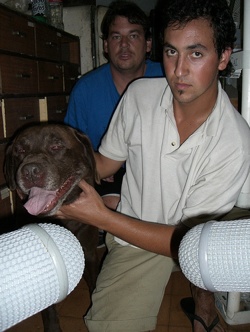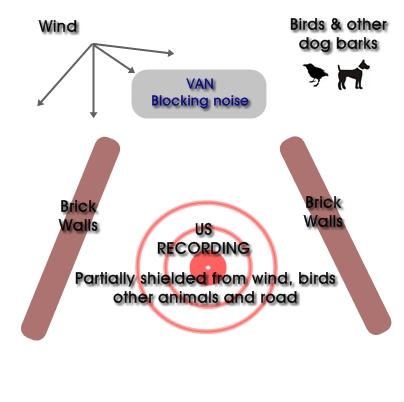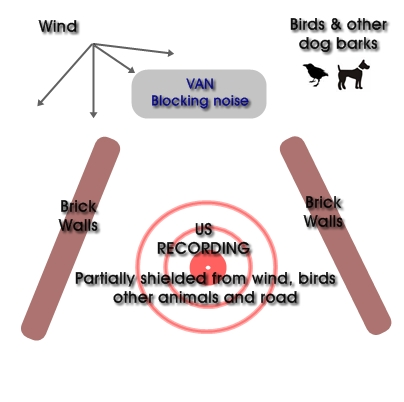Untrained dogs can be very hard to record. Unlike trained dogs, they don’t know commands and are usually scared or uneasy when put in a different environment. Also, their reactions are hard to predict and most likely they will not perform as you want them to when the time for recording comes. In order to minimize these problems there are some things you can try doing:
First of all, be calm. Animals can somehow sense your mood (especially dogs) and if you’re jumpy and stressed you will end up stressing the animal and the owner.
Always ask the owner or handler about the dog, they know it better than anyone else and can give you helpful tips on how to get a good performance. Take their advice and include them in the shoot. When recording Chihuahuas for “Beverly Hills Chihuahua” at some point we recorded over 10 untrained dogs at the same time. It was important to have the owner around to help out with the animals. We even used him on a recording: as we recorded, he would silently hide form the dogs, which made them call their owner and they make some really interesting barks.
Use body language, dogs respond to your body language as well as vocal commands. If you stand up, the dog will perceive you as an authority and may not perform the desired way. Try lowering your body at the dog’s level for a different approach. Always beware that dogs might suddenly react in an unexpected way, stay at a safe distance.
Don’t follow the dog’s head with your microphone, it will only cause the dog to move more and your recording to have more noise (inherited handheld noise. Place the mic in front of the dog so that it becomes used to it, let it sniff around it and satisfy its curiosity for the new object. After that the animal is more likely to ignore the mic and focus on what the trainer/owner is doing.
A good, safe way to record single dogs is to separate them from their owner or pack. Leaving a dog alone in a room would cause it to bark or cry, so if you have more than one dog, try separating one from the pack for it to react. Be aware that the dog might try to scratch the door of the room or make paw/nail sounds on the surface it is on, so placing a mat or blanket under it is a good idea.
On another instance of our “Beverly Hills Chihuahua“ recordings, we separated the alpha male from the pack and brought in a female dog in heat. The male dog reacted and we got great sounds of barks, groans and yelps.
On the movie ‘The Shaggy Dog’ we used handheld microphones and tracked the dog’s movements to keep the mic on axis with the vocals. As mentioned before we had a slight problem with handling noise. Anytime you track an erratic dog’s head, little moves or “mic bumps” are incurred in the recordings. Moreover, the real big problem is that waving a microphone around any dog seems to encourage the dog to move even more. It is almost as if the dog is interacting with the microphone as we try to follow his moves.
For ‘Underdog’ we took at different approach. We put a cloth collar on the dog and used three microphones: one shotgun straight on his stationary spot, a second, slightly closer stereo (X/Y) microphone to cover any dog vocals that are off axis from the shotgun mic, and the third, an onboard Sanken boundary mic applied to the cloth collar.
The end result is a tight mono shotgun recording when the dog is on axis, or a close stereo recording, and finally an ECU onboard recording that has more low end, less room, and is slightly less defined in the high frequencies.
For this same shoot we worked with an experienced dog trainer. This was very helpful as he knew the dogs well and had some tricks up his sleeve to get good sounds.
In the photo below, the dog trainer holds the dog’s mane and gently squeezes the dog’s vocal chords. This technique provided some very unique dog sounds. We had never thought of doing this before because it seemed inhumane, however, we were assured that it does not hurt the dog at all.
One of the dogs we recorded was this Great Pyrenees Mountain Dog, a male Uruguayan champion originally from France. This impressive animal weighs about 160 Lbs. He made deep guttural grunts, woofs, and had this impressive deep panting. We tried several methods to extract good sounds from him like bringing by different females in heat and other dominant male dogs. Nothing really worked, the dogs became sedate in his presence so no barking occurred.
On another shoot we had several Labrador dogs but only got good sounds from “Benny” the golden Lab puppy. Benny was great, it just took us a while to figure out how to get him to perform his crying and whimpering with the help of his owner. After some tests we found that leaving him in a room by himself he would whine at the entrance of the door so we placed two mics pointing in both plausible directions Benny would face, and then added a Sanken Boundary mic to the ground.
This wasn’t the smartest move, Benny ate the Sanken microphone cable. So another tip on recording dogs, especially puppies, is be aware of your precious equipment, don’t leave cables or anything that the dog might find chewable on the ground.
Continuing with our “BHC” shoots, we ended up at a dog breeding farm one day. It was a really nice place, nature, animals…which meant it was a terrible place for recording. The background sounds were everywhere: birds, distant dogs, people and tree leaves (it was windy on top of things). So we worked with the elements and came up with an interesting set up for that location. In order to minimize all that BG noise and wind, we created a “closed” space in the entrance of the farm that had two big brick walls on the sides. We placed a van across the entrance thus blocking the sounds that were coming from that direction (birds, dogs and more). The set up looked like this:
We also swept the floor to get rid of pebbles and took our shoes off to minimize steps.
Our goal at this place was to record mean Dobermann growls and barks. But as it usually happens with animals, the Dobermans turned out to be the sweetest dogs and were more interesting in cuddles than mean barks. The owners attributed their initial quietness to the unfamiliar environment and that their presence eased the animals too. Other animals were brought in in order to make the Doberman bark but we couldn’t get the desired sounds. Then we put our knowledge in practice and two Dobermans were taken from the recording area and once they felt they were being left alone they began barking as expected. Separating the dog and owner made the dog bark.
We noticed that physically standing up put the dogs in a submissive position making them more quiet, so sitting down next to the dog provided the best solution.
Written by Rob Nokes for Designing Sound






Another way for vicious sounds Rob, which is what we did for Chicken Run, is to find someone with a real guard dog and record that. I can tell you that’s pretty scary, but we got some fantastic sounds, real devil dog stuff.
As regards microphone technique, the longest boom possible and get ready to run. Thankfully the owner and leash were pretty strong !